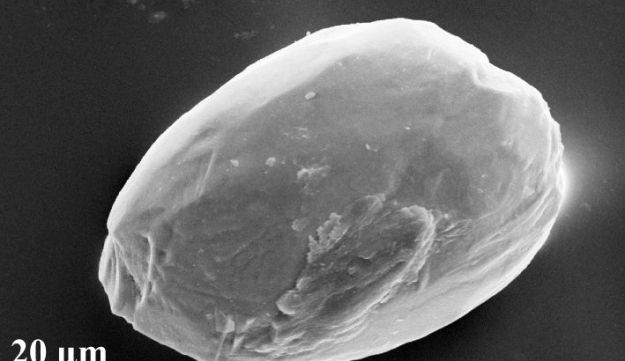Evolution of Man Began in Eastern Mediterranean, Not Africa, Say Archaeologists
Our ancestors came to Africa from the Balkans after the Sahara bloomed, say scientists based on a 7.2 million-year-old jaw and tooth

Man's evolution didn't begin in Africa, as has been axiomatic until now. It apparently began in the Mediterranean Basin, an area that includes Israel. Later, when conditions allowed, early hominins that would evolve into man descended southward to Africa, where their evolution continued.
So before Lucy the Australopithecus and before Homo heidelbergis, Homo erectus and the rest of the hominin pack was Graecopithecus freybergi, and he didn't live in Africa, but in the Mediterranean region and Balkans, reports an international group of scientists.
This paradigm-shattering theory is based on exactly two bones from the species dubbed El Graeco: a lower jaw found in Greece and an upper molar found in Bulgaria. The bones are estimated to be about 7.2 million years old.


The tooth is key to identifying El Graeco (albeit tentatively) as a human ancestor, as opposed to just another ape who died out: It features converged dental roots, Prof. Madelaine Bohme of Tubingen University told Haaretz.
Great ape dental roots diverge (usually split into two or three segments), but the roots of El Graeco converge and are partially fused, a human characteristic also found in Australopithecus, for example. Converged roots are not found in the chimpanzee line. One conclusion is that human and chimp ancestors separated earlier than the 7 million years that is commonly thought.
"We believe the split between the ancestors of chimps and humans was created in the eastern Mediterranean," Bohme says.
Finding two Graecopithecus fossils in the Mediterranean region means precisely nothing about the prevalence of this species throughout Asia and southern Europe. But Bohme shoots down the suggestion that theoretically, the beast could have also thronged Africa. When El Graeco lived, the uncrossable wasteland of the Sahara lay between habitable parts of Africa and the Mediterranean.
Separated by the Sahara
Geologists have long known that the Sahara Desert "came and went" – now it's here, but there were times in the history of the Earth that North Africa was a paradise, rich in rivers and fauna. Not in El Graeco's time, though. Both Graecopithecus fossils were found in sediment rich in dust that had blown in from the Sahara, and a hell of a lot of dust it was.
According to the scientists' data, the population north of the Sahara evolved into hominins, says Bohme. No fossil ape remains from 7 or 8 million years ago have been found (at least not yet) in Africa, but she speculates that the southern crowd stuck below the Sahara became Pan, the genus that includes the chimps and bonobos.
There is also a circumstantial case for El Graeco being the precursor of humans, not apes. At the time, Graecopithecus was living in arid savannah conditions, says Bohme.
"The climate conditions were arid. There were very few trees and the environment was very dusty, similar to the environments in the central Asian deserts or the African Sahel. From what we know about great apes, none can live in the savannah environment," she explains.
They would have choked, poor things. "The dust blowing into the Balkans from the Sahara at the time was about 250 grams dust of per square meter per year," says Bohme, "a magnitude more than the dust load today in Israel or in the Mediterranean," which is currently about 20 to 25 grams per square meter per year.

In other words, El Graeco lived in the sort of harsh environment that requires special biology or special metabolism – and/or culture – for survival, she suggests. Again that argues for primitive man, not ape.
An even older ape in the Mediterranean region
Yet more evidence backing a Mediterranean origin of man is Ouranopithecus, which existed throughout the eastern Mediterranean some 9 million years ago, and which could theoretically have been the ancestor of El Graeco. Ouranopithecus was found in Greece and seems related to fossils found in Turkey and Iran. There are no known African fossil hominins from that time. "All the African hominin fossils are younger," Bohme said.
So, if we hominins originated in the Mediterranean region, how and when did our forefathers migrate to Africa?
"Later, perhaps half million years after El Graeco, the Sahara Desert disappeared again. It was probably quite a humid period," says Bohme. Fossil river beds indicate massive flows of water, including in today's arid Libya. Lake Chad existed and was high enough to overflow. In short, the area was inviting and the man-apes, either El Graeco itself or its descendent, moved southward into this lovely landscape. The earliest-known African hominid is a good 200,000 years later than our Graeco: Sahelanthropus tchadensis.
The findings are described in two studies published in the open access scientific journal PLOS ONE, titled: "Potential hominin affinities of Graecopithecus from the Late Miocene of Europe" and "Messinian age and savannah environment of the possible hominin Graecopithecus from Europe."

Want to enjoy 'Zen' reading - with no ads and just the article? Subscribe today
Subscribe now




















